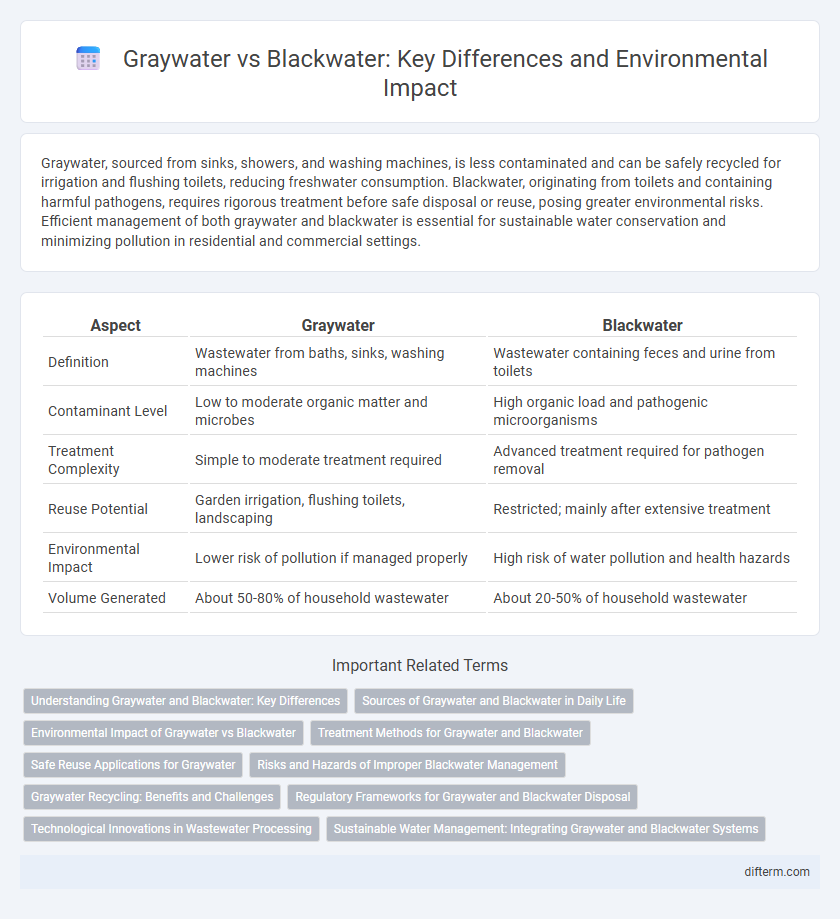Graywater, sourced from sinks, showers, and washing machines, is less contaminated and can be safely recycled for irrigation and flushing toilets, reducing freshwater consumption. Blackwater, originating from toilets and containing harmful pathogens, requires rigorous treatment before safe disposal or reuse, posing greater environmental risks. Efficient management of both graywater and blackwater is essential for sustainable water conservation and minimizing pollution in residential and commercial settings.
Table of Comparison
| Aspect | Graywater | Blackwater |
|---|---|---|
| Definition | Wastewater from baths, sinks, washing machines | Wastewater containing feces and urine from toilets |
| Contaminant Level | Low to moderate organic matter and microbes | High organic load and pathogenic microorganisms |
| Treatment Complexity | Simple to moderate treatment required | Advanced treatment required for pathogen removal |
| Reuse Potential | Garden irrigation, flushing toilets, landscaping | Restricted; mainly after extensive treatment |
| Environmental Impact | Lower risk of pollution if managed properly | High risk of water pollution and health hazards |
| Volume Generated | About 50-80% of household wastewater | About 20-50% of household wastewater |
Understanding Graywater and Blackwater: Key Differences
Graywater consists of wastewater from sinks, showers, and washing machines, typically containing fewer contaminants and suitable for recycling in irrigation and flushing toilets. Blackwater originates from toilets and contains human waste and pathogens, requiring rigorous treatment before disposal to prevent environmental contamination. Recognizing the differences between graywater and blackwater is essential for effective wastewater management and sustainable water conservation practices.
Sources of Graywater and Blackwater in Daily Life
Graywater primarily originates from household activities such as bathing, laundry, and dishwashing, containing minimal contaminants compared to blackwater. Blackwater is generated from toilets, containing human waste and pathogens requiring rigorous treatment before disposal. Understanding these distinct sources aids in developing efficient water recycling and treatment strategies to reduce environmental impact.
Environmental Impact of Graywater vs Blackwater
Graywater, consisting of gently used water from sinks, showers, and laundry, has a significantly lower environmental impact compared to blackwater, which contains sewage and hazardous pathogens. Reusing graywater for irrigation or flushing reduces freshwater extraction and minimizes wastewater treatment demands, thereby conserving resources and lowering pollution levels. In contrast, blackwater requires intensive treatment to remove contaminants, posing higher risks of soil and water pollution if improperly managed.
Treatment Methods for Graywater and Blackwater
Graywater treatment methods typically involve filtration, sedimentation, and biological processes such as constructed wetlands or membrane bioreactors to remove contaminants and pathogens, enabling safe reuse for irrigation or flushing. Blackwater treatment requires more intensive processes including primary sedimentation, anaerobic digestion, and advanced disinfection methods like chlorination or UV treatment to effectively eliminate pathogens and reduce organic load before discharge or reuse. Both treatments aim to protect environmental and public health, but blackwater demands higher energy and infrastructure investments due to its higher contamination levels.
Safe Reuse Applications for Graywater
Graywater, comprising wastewater from showers, sinks, and laundry, is suitable for safe reuse applications such as landscape irrigation and toilet flushing, significantly reducing freshwater consumption. Proper treatment through filtration and disinfection minimizes health risks and prevents pathogen transmission, making graywater a sustainable alternative in water conservation efforts. Unlike blackwater, which contains fecal matter and requires complex treatment, graywater reuse offers an efficient, low-risk solution for non-potable water needs in residential and commercial settings.
Risks and Hazards of Improper Blackwater Management
Improper blackwater management poses significant risks including the contamination of groundwater and surface water with pathogens, leading to severe public health hazards such as cholera, dysentery, and hepatitis. Exposure to untreated blackwater can cause environmental pollution, resulting in oxygen depletion in aquatic ecosystems and the disruption of biodiversity. Unlike graywater, blackwater contains high concentrations of organic matter and harmful microorganisms, making its improper disposal particularly dangerous for both human health and the environment.
Graywater Recycling: Benefits and Challenges
Graywater recycling reduces freshwater consumption by reusing wastewater from sinks, showers, and laundry for irrigation and toilet flushing, significantly lowering household water bills and easing strain on municipal systems. It minimizes environmental pollution by diverting less contaminated water from sewage treatment plants, reducing energy use and greenhouse gas emissions associated with wastewater processing. However, challenges include the need for proper filtration and disinfection systems to prevent health risks, potential regulatory barriers, and infrastructure costs that can limit widespread adoption.
Regulatory Frameworks for Graywater and Blackwater Disposal
Regulatory frameworks for graywater and blackwater disposal differ significantly due to their composition and associated health risks. Graywater, which includes wastewater from sinks, showers, and laundry, is often subject to less stringent regulations and can be reused for non-potable applications under specific guidelines to reduce freshwater consumption. Blackwater, containing sewage and toilet waste, requires strict treatment and disposal regulations to prevent environmental contamination and protect public health, often mandated by local, state, and federal environmental protection agencies.
Technological Innovations in Wastewater Processing
Advanced membrane bioreactors and electrochemical treatment systems are revolutionizing the distinction between graywater and blackwater by enabling efficient separation and purification for reuse. Innovations such as enzymatic and microbial fuel cell technologies enhance the degradation of contaminants, making graywater suitable for irrigation and blackwater safe for energy recovery and nutrient extraction. These technologies reduce environmental impact by minimizing wastewater discharge and promoting sustainable water management solutions.
Sustainable Water Management: Integrating Graywater and Blackwater Systems
Integrating graywater and blackwater systems enhances sustainable water management by reducing freshwater demand and minimizing wastewater discharge. Graywater, sourced from sinks and showers, can be reused for irrigation and flushing, while blackwater, containing human waste, requires more intensive treatment for safe reuse or disposal. Combining these systems supports resource recovery, reduces environmental pollution, and promotes circular water use in urban and agricultural settings.
graywater vs blackwater Infographic

 difterm.com
difterm.com